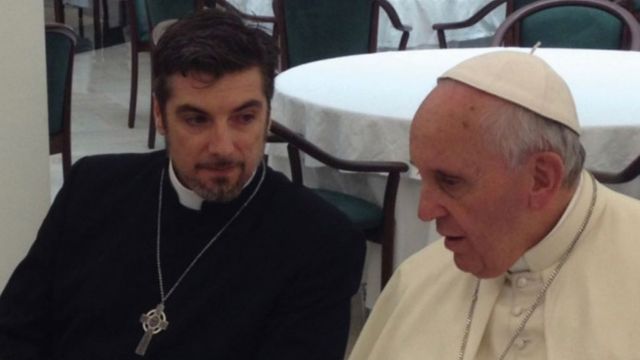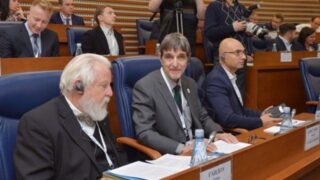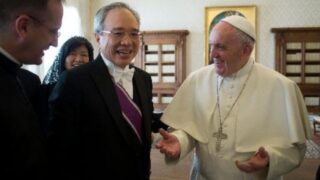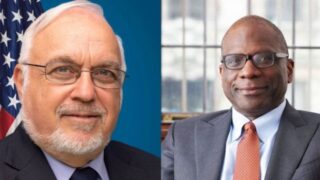A visit to the exhibition “Bergerac and Protestantism” and a dialogue on “basic orthodoxy” as a need in our secular age.
by Marco Respinti
Article 2 of 2. Read article 1.


In the first article of this series, I discussed the crucial role of Bergerac as a border town during the bloody Wars of Religion. Five hundred centuries later, Madame Brigitte welcomes pilgrims and tourists at the exhibition “Bergerac et le protestantisme” in the Lutheran Temple of her town, asking where they come from. To me, she proudly underlines that Italy has a large Protestant community. Delicately, I warn her that I am a Roman Catholic. “Well, I am a Catholic too, am I not?” she promptly answers, both smiling and seriously, “After all, Martin Luther was a Catholic too.” I am both surprised and not.
In 1992, during the Quincentennial of the Discovery of America, I interviewed Professor Burton W. Folsom Jr., at that time teaching History at Hillsdale College in Hillsdale, Michigan. He retired in December 2016. On the birth of modernity, he proposed an “hermeneutic of continuity” that put together a “medieval Christopher Columbus” (1451–1506), Thomas Aquinas (1225–1274), and Luther. They were different characters, yes, and deeply so, but were part of the same culture that shaped a “new Christendom” for a new world (later including even the New World of “Europe in America”).
Folsom, a member of the Assemblies of God, a Protestant Pentecostal denomination, was not naïve—no more than English Anglican divine Richard Hooker (1554–1600), one of the major theological authorities of his time and church. He was called the “Aquinas of the Church of England” for his large use of Thomas’ “Summa theologiae” in post-Reformation England. In his 1952 The New Science of Politics, German-American philosopher Eric Voegelin (1901–1985) indicated him as a major antidote to modern ideology. Italian historian of law Alessandro Passerin d’Entrèves (1902–1985) supported the argument with his 1934 “Appunti di storia delle dottrine politiche: la filosofia politica medioevale” (Turin: Giappichelli), published in English in 1939 as “The Medieval Contribution to Political Thought: Thomas Aquinas, Marsilius of Padua, Richard Hooker.”


In the U.S., I also discussed the topic with Professor John R. White, an expert of Late Medieval thought, for a long time an academic philosopher, and now a Jungian psychoanalyst and scholar-in-residence at Duquesne University, in Pittsburgh, Pennsylvania. His comments added much to the concept of the “catholicity of the reformation,” to borrow from the title of a 1996 intriguing book of essays, edited by American Lutheran theologians Carl Edward Braaten and Robert W. Jenson (1930–2017). The text argued that Reformers aimed at renewing, not disrupting the Catholic Church. Of course, this is disputable, but the intention of the book should be much appreciated.
Madame Brigitte in Bergerac perfectly knows that Lutherans and Anglicans confess the Apostles’ Creed, the line “I believe in the holy catholic church” included. Pastor Levi Power, of Mount of Olives Lutheran Church in Rock Springs, Wyoming, says it clearly: “The Reformation was catholic. Not Roman. Universal.” He plays on the etymology of the word “catholic,” derived from the Ancient Greek “καθολικός,” “katholikos,” meaning “universal.” Reformed Christians explain the use of the adjective “catholic” in the Apostles’ Creed as “the true Christian church of all times and all places.” But obviously Catholics too think that their church is the true and universal one—in fact, they call themselves “Catholics” for this very reason.
This generalized use of the word “Catholic” is the reason why in countries and contexts where the presence of “Protestant Catholics” is large (and in English-speaking countries in general, where for examples Anglo-Catholics exist), Catholics call themselves, and are called, “Roman” Catholics, thus underlining their persuasion as “Papists.”
It is also worth noting that the term “Protestant” originally had a political meaning—or a geo-religious use in politics. In 1521, the Holy Roman Empire, a Catholic supranational institution, held one of its periodical general deliberative assemblies called “Diets” in the city of Worms, in present-day Germany. Here Luther, called to take a final stand on the theological views he had expressed in 1517, confirmed them and was formally declared a heretic. The schism dividing Western Christendom was consumed. But in 1526, the Diet of Speyer (also from the name of the city in present-day Germany where it was held) somewhat froze the situation, postponing further decisions to a later general consultation. A new Diet convened in Speyer in 1529, repudiated the 1526 conclusions, and formalized the split among Christians. It was there that Lutheran dignitaries issued a formal protest against the resolutions of the Diet, becoming known as “Protestants.”


For a considerable span time, the term was not substantially used outside the German-speaking world and on the religious map of those times mainly retained a political connotation. Only later it was applied to all Reformed Christians, while Luther insisted to call his flock “Evangelical” or simply “Christian.” The first of the two terms that Luther preferred came then into major use with a new wave of Protestantism, and a renewed Protestant religious afflatus, in the first half of the 18th century. It was later widely used in the English-speaking word as a mark of yet another spiritual Protestant renaissance, sometimes indicated as “born again.” The second term, aimed at confessing the essentiality of the Christian faith, is used today as a self-describing synonym of “Reformed.” Yet, it seems to attribute the unicity of being Christian to Protestants, conveying the bizarre idea that non-Protestant Christians may not be Christians—which of course both Catholics and Protestant advocates of the “catholicity of the Reformation” reject.
In Bergerac’s Lutheran temple, Madame Brigitte unintentionally gave testimony to a meek yet strong anxiety that seems to circulate, consciously or not, among several different Chistian churches and sects. It is the search for, or the aspiration to, a “basic orthodoxy” that different brands of Christians need at the end of the day to share to retain a non-negotiable loyalty to a set of fundamental doctrinal and moral principles, preserving the authenticity of the message of Jesus and the “early church” (whatever this may mean). In 1952, Irish writer, literary scholar and Anglican theologian C.S. Lewis (1898–1963) published a book on a similar subject, entitled “Mere Christianity.”
The concern of these groups is to avoid latitudinarian and liberal interpretations of Christianity that may end misrepresenting Jesus’ message. But a definition of “Christian” is not easily to achieve. An essential one is considering “Christian” all those who acknowledge Jesus Christ as their divine savior, even if some find this definition too large, others too strict, and all definitions may be discussed.
This writer has encountered this informal “movement” several times at different latitudes of (chiefly) the English-speaking world. It discloses a deep anthropological exigence that reveals an authentic spiritual need and results in an appreciable sociological phenomenon. Without excluding them, it goes beyond scholarly debates. Hundreds of years after the division of Christendom, it is uttered by the several Mesdames Brigitte who testify a longing for a lost unity that tells much about the age of secularization that never came, the post-modern need for certitudes, the insuppressible religious nature of human beings, and even what is wrong in the French “laïcité.”
It should not be confused with a vulgar attempt to deny discriminating theological differences, or the wishful thinking of some late do-gooders. Rather, it is to be considered a sign of the times—rough and perhaps simplistic, but at the same time genuine.


The late Tony Palmer (1966–2014) was a British-born South African bishop in the Communion of Evangelical Episcopal Churches, which was founded in 1995 in the U.S. and adheres to the Anglican Communion. He met and had in-depth discussion with Francis, Pope of the Catholic Church, and also introduced the Catholic Pontiff to the crowd of believers gathered by Word of Faith’s Pastor Kenneth Copeland at the Texas Charismatic Evangelical Leadership Conference, in February 2014. The basic tenet of Father Palmer (as he was called in his community, not “Bishop”) was “The protest of Martin Luther is over.” Probably it isn’t—but can we easily ignore Madame Brigitte?









